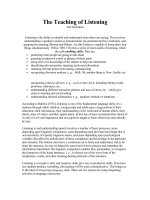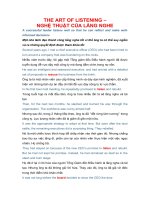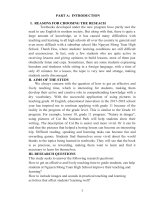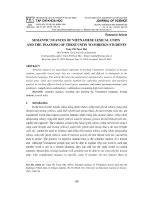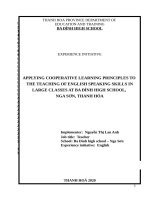The Teaching of Listening
Bạn đang xem bản rút gọn của tài liệu. Xem và tải ngay bản đầy đủ của tài liệu tại đây (104.78 KB, 8 trang )
The Teaching of Listening
Arif Saricoban
Listening is the ability to identify and understand what others are saying. This involves
understanding a speaker's accent or pronunciation, his grammar and his vocabulary, and
grasping his meaning (Howatt and Dakin). An able listener is capable of doing these four
things simultaneously. Willis (1981:134) lists a series of micro-skills of listening, which
she calls enabling skills. They are:
• predicting what people are going to talk about
• guessing at unknown words or phrases without panic
• using one's own knowledge of the subject to help one understand
• identifying relevant points; rejecting irrelevant information
• retaining relevant points (note-taking, summarizing)
• recognizing discourse markers, e. g. , Well; Oh, another thing is; Now, finally; etc.
recognizing cohesive devices, e. g. , such as and which, including linking words,
pronouns, references, etc.
• understanding different intonation patterns and uses of stress, etc. , which give
clues to meaning and social setting
• understanding inferred information, e. g. , speakers' attitude or intentions.
According to Bulletin (1952), listening is one of the fundamental language skills. It's a
medium through which children, young people and adults gain a large portion of their
education--their information, their understanding of the world and of human affairs, their
ideals, sense of values, and their appreciation. In this day of mass communication (much of
it oral), it is of vital importance that our pupils be taught to listen effectively and critically,
he says.
Listening to and understanding speech involves a number of basic processes, some
depending upon linguistic competence, some depending upon previous knowledge that is
not necessarily of a purely linguistic nature, and some depending upon psychological
variables that affect the mobilization of these competence and knowledge in the particular
task situation. The listener must have a continuous set to listen and understand, and as he
hears the utterance, he may be helped by some kind of set to process and remember the
information transmitted. His linguistic competence enables him, presumably, to recognize
the formatives of the heard utterance, i. e. , to dissect out of the wave form of the
morphemes, words, and other meaning-bearing elements of the utterance.
Listening is a receptive skill, and receptive skills give way to productive skills. If we have
our students produce something, the teaching will be more communicative. This brings us
to the must of integrating language skills. There are two reasons for using integrating
activities in language classrooms:
1. To practice and extend the learners' use of a certain language structure or function
2. To develop the learners' ability in the use of two or more of the skills within real
contexts and communicative frame work.
Integrated activities, on the other hand, provide a variety in the classroom and thus
maintain motivation and allow the recycling and revision of language which has already
been taught separately in each skill.
How can we be certain that listening experiences will become more productive? Wittich
tells us to distinguish the four levels existing in listening to radio or recordings:
• Level 1. This mood is listening. Here, the sound remains in the background - there
is usually limited comprehension, and, indeed, limited attention. One becomes
directly aware of sounds only when they stop. Nevertheless, a certain amount of
learning may take place.
• Level 2. Here the purpose is relaxation, escape, getting your mind off something
rather than on it. The material is comprehended but usually not analyzed for its
value. This listening may result in useful ideas, but they are usually peripheral
and/or accidental.
• Level 3. On this level, answers are sought as a key to action. One listens to weather
reports, traffic information from a plane-temporarily useful but what we might call
forgettable transient information. This form of listening does not require long,
sustained concentration.
• Level 4. This is the stage of analytical and critical listening. The listener not only
seeks a serious answer to a serious question but evaluates the quality of the answer.
Round-table discussions, serious listening to talks, spirited conversation,
symphonic music are at the fourth level. At this stage, listening to music is in the
foreground of attention not in the background as on previous levels (Wittich and
Schuller, 1962).
It is listening on the fourth level that primarily concerns us in our teaching. Such listening
may add an emotional and dramatic quality. Radio and recordings highlight the importance
of listening. Listening is as active as speaking (the other receptive skill), and in some ways
even more difficult. It well requires attention, thought, interpretation, and imagination. To
improve our learners' listening skills we should let them (Austin Shrope, 1970):
1. Adopt a positive attitude.
2. Be responsive.
3. Shut out distractions.
4. Listen for the speaker's purpose.
5. Look for the signals of what is to come.
6. Look for summaries of what has gone before.
7. Evaluate the supporting materials.
8. Look for non-verbal clues.
We can call listening a decoding -making sense of the message process. Each short stretch
of meaningful material which is read or heard has to be;
• (I) recognised as meaningful and understood on perception
• (II) held in the short term memory long enough to be decoded
• (III) related to what has gone before and /or what follows.
Out of this process come pieces of information which can be stored in the long term
memory for recall later. We can show the whole process in the form of a model (Abbott
and Wingard, 1985).
1. Perception of sounds, letter shapes, etc.
2. Initial recognition of meaning of short stretches
3. Material held in short term memory
4. Related to material already held in short term memory
5. Related to material arriving in short-term memory
6. Meaning extracted from message and retained in long-term memory
7. Gist recalled later
We can divide the listening process into 3 stages;
1. Pre-listening (purpose must be given at this stage),
2. During (in-while) listening,
3. Post -listening (speaking).
There is an association between expectation, purpose, and comprehension, therefore a
purpose should be given to our learners. We should train students to understand what is
being said in conversations to get them to disregard redundancy, hesitation, and
ungrammaticality. The major problem is the actual way listening material is presented to
the students. We should give a clear lead in what they are going to hear; use some kind of
visual back up for them to understand; give questions and tasks in order to clarify the
things in their minds; and be sure that these tasks help in learning, not confusing. Students
should learn how use the environmental clues; the speaker's facial expression, posture, eye
direction, proximity, gesture, tone of voice, and that general surroundings contribute
information.
In listening activities, we listen for a purpose. We make an immediate response to what we
hear. There are some visual or environmental clues as to the meaning of what is heard.
Stretches of heard discourse come in short chunks, and most heard discourse is
spontaneous, therefore differs from formal spoken prose in the amount of redundancy
'noise' and colloquialisms, and its auditory character.
In listening to English as a foreign language, the most important features can be defined as:
1. Coping with the sounds,
2. Understanding intonation and stress,
3. Coping with redundancy and noise,
4. Predicting,
5. Understanding colloquial vocabulary,
6. Fatigue,
7. Understanding different accents,
8. Using visual and environmental clues.
This brings us to the thought that, while planning exercises, listening materials, task and
visual materials should be taken into consideration. The teacher should produce a suitable
discourse while using recordings. A preset purpose, ongoing learner response, motivation,
success, simplicity, and feedback should be the things considered while preparing the task.
Visual materials are useful for contextualization. We can also categorize the goals of
listening as listening for enjoyment, for information, for persuation, for perception and
lastly for comprehension and lastly to solve problems.
We can divide listening for comprehension into three stages;
1. Listening and making no response (following a written text, informal teacher talk)
2. Listening and making short responses (obeying instructions - physical movement,
building models, picture dictation. etc.), true- false exercises, noting specific
information, etc.
3. Listening and making longer response (repetition and dictation, paraphrasing,
answering questions, answering comprehension questions on texts, predictions,
filling gaps, summarizing, etc)
The purposes that should be in a listening activity are giving/providing:
1. General information (understanding of the main points)
2. Specific information (understanding of the particular items)
3. Cultural interest (generally informing about the target language culture)
4. Information about people's attitudes and opinions
5. The organization of ideas
6. Sequence of events
7. Lexical items (words expressing noise / movement)
8. Structural items (their use and meaning)
9. Functional items (their form and use)
Lack of sociocultural, factual, and contextual knowledge of the target language can present
an obstacle to listening comprehension. In his Language and Language Learning (1960),
Brooks discusses vital points for the student to be aware of, such as contradictions and
omissions -aspects of sandhi-variation (the changes occur in natural speech as a result of
environment, stress, intonation, rate of speed and so forth). Though Brook does not
specially refer to the term " sandhi-variation ", he does refer to the phenomenon of sadhi in
his examples: Jeet jet? (Did you eat yet?) (p. 50) . According to Brooks, native speakers in
an informal situation "habitually reduce the clarity of speech signals to the minimum
required for comprehension. "Brooks believes that it is necessary to give consideration also
to the interdependence of language and culture; for example, register, expletives, verbal
taboos, culture-bound vocabulary. He also mentions that there is a need to clarify and point
out the differences between written and spoken English.
In order to teach listening skills, a teacher should firstly state the difficulties. For a student
of a foreign language, accurate and intelligent listening is a necessity, and the teacher is
responsible to help his / her learners to acquire this skill which provides the very
foundation for learning and functioning in a language. That the teacher can observe and
isolate the errors in speaking, but could not in listening is a difficulty. In listening, the
learner can exercise no controls over the structural and lexical range of the speaker to
whom he is listening. Nevertheless, any listener can learn to focus on significant content
items, to explain in another way he can learn to listen selectively.
Helping the learners to distinguish sounds, teaching to isolate significant content and
informational items for concentration may be provided by controlled listening exercises.
One exercise is to give him certain performance objectives -to give him general
informational questions that he should be able to answer after he listens the material for the
first time. These questions should require only the isolation of facts clearly revealed in the
material. Questions that require application or inference from the information contained in
the listening exercise are best used at later stages or more advanced students.
More controls are necessary at less advanced levels. Sheets containing sequentially
organized and significant questions on context and content -questions that call for one-
word answers -serve as useful guides for the student. Such questions help him filter out and
listen for significant information. The questions themselves suggest the content and provide
the student with an organizational frame for selective listening.
For listening comprehension exercises, we tend to read passages, record news or
broadcasts, or prepare lectures. All of them have value, but they are extremely difficult
sources for early practice in selective listening. This type of listening exercises does not
present the redundancies, the colloquialisms, the hesitations, the gestures and the facial
expressions that are an inseparable part of the spoken language. They emphasize
informational content and fail to provide the signals used to communicate information and
meaning.
Since most of the actual listening the student will be exposed to outside of the class is
likely to be real-life conversation, it seems wisest to use materials cast in real-life situations
for listening comprehension exercises -at least at the beginning level. If the oral instruction
of the course is contextualized -set into a " situation " - it should be easy enough to
contextualize the aural practice as well. The teacher can easily adapt to listening exercises
those situations through which the text presents oral drills and communicative activities,
just by giving them a slightly different twist. Listening exercises should be as natural as the
situations from which they grow. In other words, an exercise in listening comprehension
must be as close as possible to a "slice of life" -neither a contrived situation nor an
artificially delivered discourse. By means of this, a teacher has a great work to do, and has
to be a very creative person in order to teach listening communicatively.
Lesson Plan
Topic: Beauty Contest
